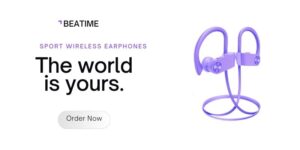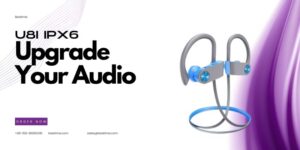
In the competitive world of audio technology, understanding the nuances that contribute to superior sound quality is essential. One critical factor is the size of the driver within earphones. But how exactly does driver size influence sound quality, and what implications does this have for B2B clients in the audio industry?
Driver size significantly impacts an earphone’s ability to reproduce various frequencies, affecting bass response, clarity, and overall sound quality. Larger drivers can produce deeper bass, while smaller drivers may excel in higher frequency clarity.
To fully grasp the importance of driver size, it’s crucial to delve into the mechanics of earphone drivers, their types, and how their dimensions influence audio performance.
Table of Contents
What Is an Earphone Driver and How Does It Work?
An earphone driver is a miniature speaker component responsible for converting electrical signals into audible sound. It comprises several parts:
- Diaphragm: A thin membrane that vibrates to produce sound waves.
- Voice Coil: Moves in response to electrical signals, causing the diaphragm to vibrate.
- Magnet: Creates a magnetic field that interacts with the voice coil.
In essence, the driver functions by receiving electrical audio signals, which cause the voice coil to move within the magnetic field, leading the diaphragm to vibrate and produce sound waves.

Understanding this mechanism is fundamental to appreciating how variations in driver size can alter sound reproduction. Learn more about what is an earphone driver and how it works1.
Dive Deeper into Earphone Driver Mechanics
1. Driver Sizes in Different Earphone Types
Earphones come in various designs, each accommodating different driver sizes:
- In-Ear Monitors (IEMs): Typically utilize drivers ranging from 8mm to 15mm in diameter.
- Over-Ear Headphones: Employ larger drivers, often between 20mm and 50mm.
The compact nature of in-ear designs necessitates smaller drivers, while over-ear models can house larger ones, influencing their respective sound profiles.
2. The Role of Driver Components
Each component within the driver plays a pivotal role:
- Diaphragm Material and Size: Affects the driver’s responsiveness and the range of frequencies it can accurately reproduce.
- Voice Coil Dynamics: Determines the efficiency and precision of diaphragm movement.
- Magnetic Strength: Influences the driver’s sensitivity and overall sound output.
Explore driver components and their impact on sound2.
How Does Driver Size Influence Sound Quality?
The size of the driver directly affects its capacity to move air, which is essential for sound production. This movement influences various aspects of sound quality:
Larger drivers can move more air, often resulting in enhanced bass response and a fuller sound. However, they may also introduce challenges in reproducing higher frequencies with the same precision as smaller drivers.
Dive Deeper into the Impact of Driver Size
1. Frequency Response and Driver Size
- Bass Frequencies: Larger drivers excel at producing low-frequency sounds due to their ability to displace more air, creating deeper bass tones.
- Mid and High Frequencies: Smaller drivers may offer better performance in higher frequency ranges, providing clarity and detail in vocals and treble.
| Driver Size | Bass Response | Treble Clarity |
|---|---|---|
| Large | Enhanced | Moderate |
| Small | Moderate | Enhanced |
This balance is crucial for achieving a well-rounded sound profile that caters to diverse listening preferences. Learn more about how driver size influences sound quality3.
2. Sound Pressure Level (SPL) and Loudness
Driver size can also influence the earphone’s SPL, affecting its loudness capabilities:
- Larger Drivers: Capable of producing higher SPLs, resulting in greater potential loudness.
- Smaller Drivers: May have lower SPLs but can still deliver sufficient volume for personal listening.
3. Physical Constraints and Design Considerations
Incorporating larger drivers into earphones presents design challenges:
- Size and Weight: Larger drivers increase the overall size and weight of the earphones, potentially affecting comfort and portability.
- Fit and Seal: Ensuring a proper fit with larger drivers can be more complex, which is critical for optimal sound isolation and bass response.
Explore design considerations for larger drivers4.
What Are the Different Types of Earphone Drivers and Their Impact on Sound?
Beyond size, the type of driver used in earphones significantly influences sound quality. Learn more about types of earphone drivers and their performance5.
The main types include:
- Dynamic Drivers: Utilize a diaphragm attached to a voice coil within a magnetic field.
- Balanced Armature Drivers: Employ an armature that pivots within a magnetic field to move the diaphragm.
- Planar Magnetic Drivers: Feature a diaphragm embedded with conductive wire between two magnetic fields.
- Electrostatic Drivers: Use a thin, electrically charged diaphragm between two conductive plates.
Each driver type has inherent characteristics that affect sound reproduction, and their performance can be influenced by their size.
Dive Deeper into Driver Types and Their Characteristics
1. Dynamic Drivers
- Sound Profile: Known for robust bass and a warm sound signature.
- Size Range: Typically larger, ranging from 8mm to 15mm in earphones.
- Advantages: Capable of producing a wide frequency range with good sensitivity.
- Considerations: Larger dynamic drivers can enhance bass but may sacrifice some treble clarity.
2. Balanced Armature Drivers - Sound Profile: Offer detailed and accurate sound, particularly in mid and high frequencies.
- Size Range: Smaller in size, often around 4mm to 7mm.
- Advantages: Precise sound reproduction with high efficiency.
- Considerations: May lack strong bass response unless combined with dynamic drivers in a hybrid setup.
3. Planar Magnetic Drivers - Sound Profile: Deliver clear and detailed sound with fast transient response.
- Size Range: Generally larger, making them less common in in-ear designs.
- Advantages: Excellent sound quality with low distortion.
- Considerations: Larger size limits their use in compact earphone designs.
4. Electrostatic Drivers - Sound Profile: Exceptional clarity and detail with a natural soundstage.
- Size Range: Typically larger, used in high
How Do Other Factors Interact with Driver Size to Affect Sound Quality?
Driver size does not act alone. Discover how acoustic design, materials, and power influence performance6.
What Are the Practical Considerations for B2B Clients Regarding Driver Size?
Understand B2B considerations for driver size7, from market trends to cost-performance balance.
Conclusion
Driver size is a cornerstone of earphone sound quality, influencing bass, clarity, and overall tonal balance. Larger drivers excel in producing deep bass but may face challenges with higher frequencies, while smaller drivers prioritize clarity and precision.
However, driver size alone does not determine sound quality. Factors like acoustic design, diaphragm materials, and integration with advanced technologies also play vital roles.
Footnotes
- Explanation of the mechanics of earphone drivers and their components.
- Analysis of how driver components affect performance.
- Insights into the relationship between driver size and sound reproduction.
- Considerations for integrating larger drivers into compact designs.
- Comparison of dynamic, balanced armature, planar magnetic, and electrostatic drivers.
- Overview of additional factors like acoustic chambers and diaphragm materials.
- Practical guidance for B2B clients balancing costs and features.









